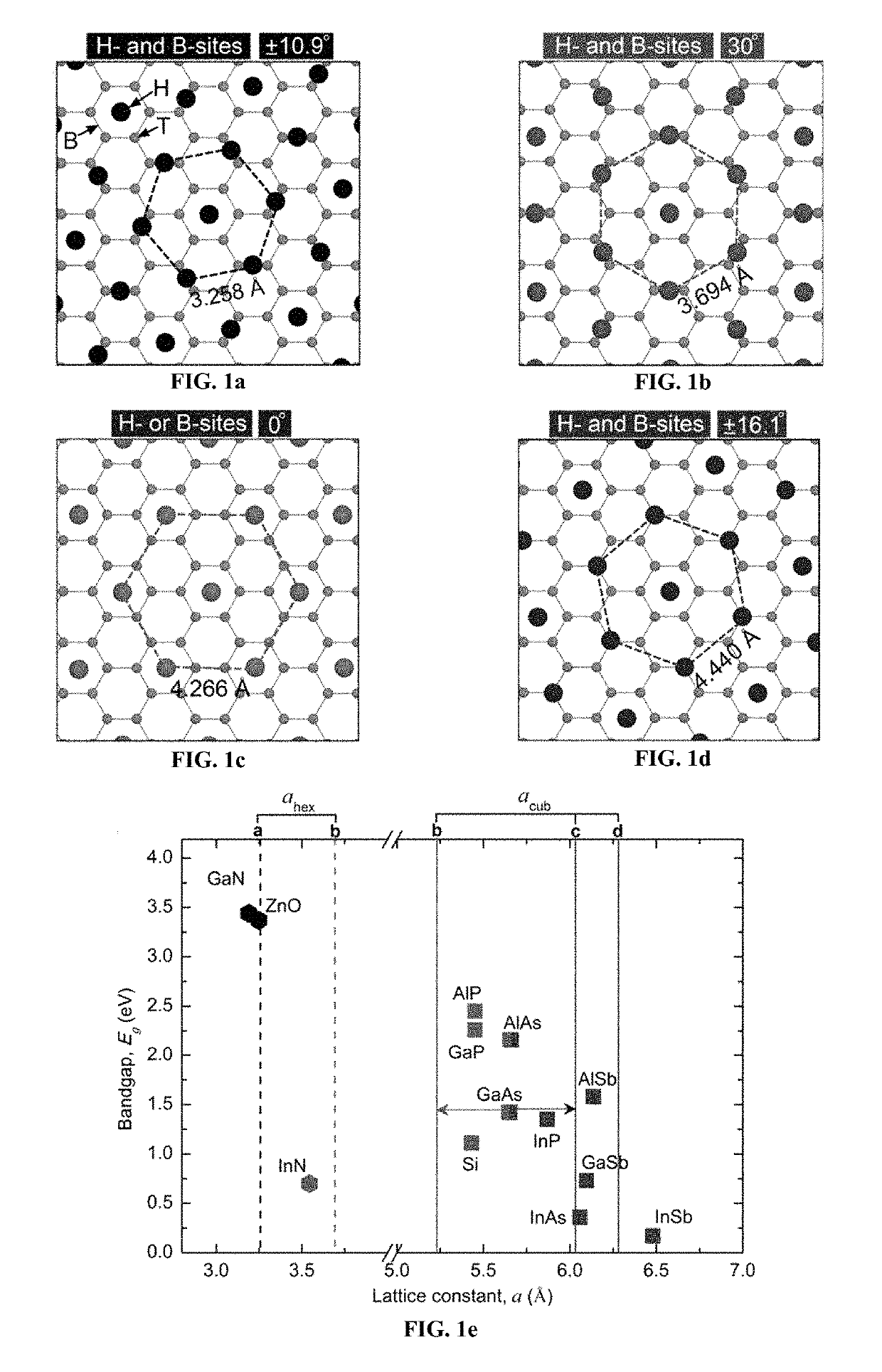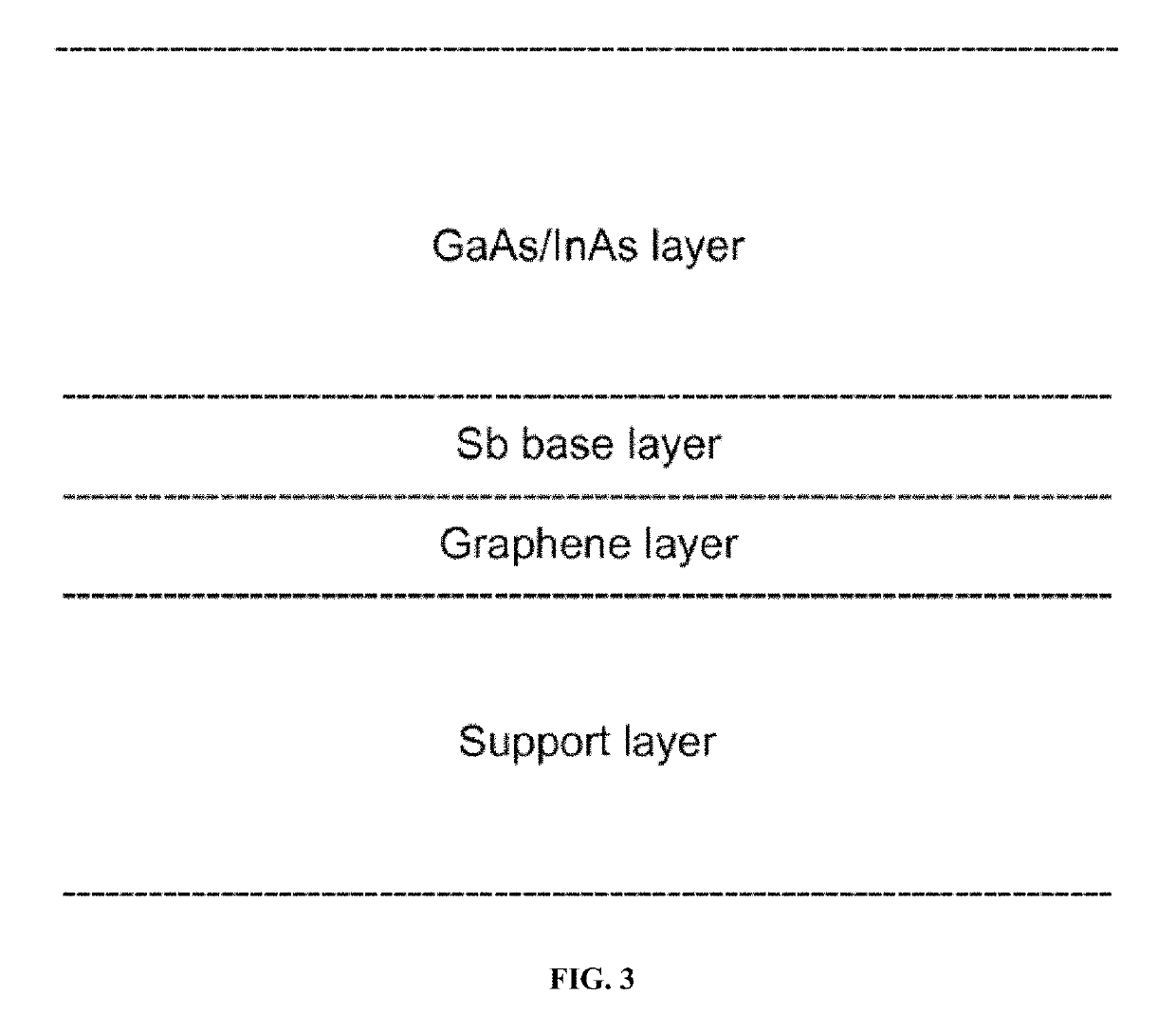III-V or II-VI compound semiconductor films on graphitic substrates
a technology of compound semiconductor films and graphitic substrates, which is applied in the direction of crystal growth process, polycrystalline material growth, chemically reactive gases, etc., can solve the problems of high cost, high limit, and inability to use the same material as a substrate, and achieve the effect of enhancing the epitaxial growth of films
- Summary
- Abstract
- Description
- Claims
- Application Information
AI Technical Summary
Benefits of technology
Problems solved by technology
Method used
Image
Examples
example 1
[0143]After annealing the graphene substrate at 550° C., the substrate temperature is then decreased to typically between 200° C. and 300° C. for Sb deposition. Sb flux is first supplied to the surface during a time interval typically in the range 5 s to 1 minute, dependent on Sb flux and substrate temperature. A few nm, preferably less than a few tens of nm, of Sb are then grown, preferably by MEE or ALMBE. Then, the substrate temperature is increased to a temperature suitable for GaSb thin film growth: i.e. around 450° C. The temperature of the Ga effusion cell is preset to yield a nominal planar growth rate of 0.3 μm per hour. The Sb2 flux is set to 1×10−6 Torr to grow the GaSb thin film at this temperature. The GaSb thin film is doped to a level appropriate for which device structure will be grown on top of this thin film template structure.
example 2
[0144]After annealing the graphene substrate at 550° C., the substrate temperature is decreased to between 15° C. and 80° C. for As deposition, the temperature being dependent on which deposition rate is wanted. As flux is first supplied to the surface during a time interval typically in the range 5 s to 1 minute. A few nm, preferably less than a few tens of nm, InAs are then grown, preferably by MEE or ALMBE. Then, the substrate temperature is increased to a temperature suitable for InAs thin film growth: i.e. around 450° C. The temperature of the In effusion cell is preset to yield a nominal planar growth rate of up to 0.7 μm per hour. The As2 flux is set to 6×10−6 Torr to form the InAs thin film at this temperature. The InAs thin film is doped to a level appropriate for which device structure will be grown on top of this thin film template structure.
[0145]The substrates prepared in examples 1 and 2 hereby called as III-V / GP thin film substrate can be used as a template for the fa...
example 3
[0147]p-i-n doped homojunction GaSb thin film is further grown on III-V / GP thin film substrate of example 1 to use it as a photodetector. The thickness of each of the p-doped, n-doped, and intrinsic III-V epilayer is typically kept between 0.5 and 3 μm. For p-type doping, Be is used. Te is used as an n-dopant. The Be cell temperature is set to 990° C. which gives a nominal p-type doping concentration of 3×1018 cm−3. The Te cell temperature is set to 440° C. which gives a nominal n-type doping concentration of 1×1018 cm−3. The deposition temperature for all the layers is set to 450° C. The temperature of the Ga effusion cell is preset to yield a nominal planar growth rate of 0.7 μm per hour, and the Sb2 flux is set to 1×10−6 Torr to grow the GaSb thin film.
PUM
| Property | Measurement | Unit |
|---|---|---|
| thickness | aaaaa | aaaaa |
| thickness | aaaaa | aaaaa |
| interplanar spacing | aaaaa | aaaaa |
Abstract
Description
Claims
Application Information
 Login to View More
Login to View More - R&D
- Intellectual Property
- Life Sciences
- Materials
- Tech Scout
- Unparalleled Data Quality
- Higher Quality Content
- 60% Fewer Hallucinations
Browse by: Latest US Patents, China's latest patents, Technical Efficacy Thesaurus, Application Domain, Technology Topic, Popular Technical Reports.
© 2025 PatSnap. All rights reserved.Legal|Privacy policy|Modern Slavery Act Transparency Statement|Sitemap|About US| Contact US: help@patsnap.com



